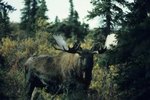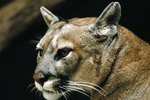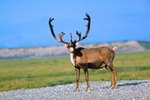
The American bison is historically a migratory beast, and though his species now lives in a space less than 1 percent of its former range, he still benefits from pre-European settlement adaptations. Because they once relied so heavily on regular migration, and also because they were once hunted in large numbers by Native Americans, bison are equipped with adaptations that make traveling easier and safer.
Where Bison Roam
Though they occupy only a small fraction of their former territory, bison once lived as far north as Alaska and as far south as Mexico. They migrated in search of food, traveling seasonally so they could follow the growth of plant life, primarily grasses. Because they live in herds and consume so much food -- a single bison can weigh more than a ton and consume more than 30 pounds of grass daily -- they had to move depending on the availability of vegetation.
Migration Adaptations
Making migration easier, bison are fast and strong travelers. They can run as fast as 40 miles per hour and are capable swimmers, too, allowing them to safely and quickly traverse a wide variety of habitats. Their large bodies and thick fur keep them protected from the elements when living in cold, snowy environments, and they can use the longer hair in front to sweep away snow as they dig through to the vegetation underneath. They are adapted to living in groups, as well, falling into a social hierarchy that simplifies migration -- the herd travels in a line, efficiently ensuring that no one is lost in the shuffle.
Threats to Bison
Despite their large size, American bison historically have faced a variety of threats. Prior to Europeans settling in North America, they were primarily hunted by Native Americans, but over the course of the 19th century, they were hunted nearly to extinction by settlers. As of 2013, the American bison is an endangered species, threatened mostly by predators like wolves and mountain lions.
Self-Defense Adaptations
Because bison generally live and feed in open plains, they are well-adapted to detecting approaching dangers. For example, bison have finely tuned senses of hearing and smell, which they use to detect potential threats -- this also makes up for their comparably poor sense of sight. Both male and female bison sport a pair of sharp, curved horns, which they use to fend off predators. Because of this beast's size, strength and formidable horns, they are typically only preyed upon when they are young, old or otherwise weakened by injury or illness.
References
Photo Credits
-
Jupiterimages/Photos.com/Getty Images
Writer Bio
Tom Ryan is a freelance writer, editor and English tutor. He graduated from the University of Pittsburgh with a degree in English writing, and has also worked as an arts and entertainment reporter with "The Pitt News" and a public relations and advertising copywriter with the Carnegie Library of Pittsburgh.




